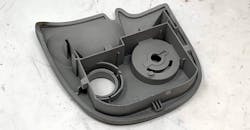Cutting Leadtime for High-Value Patterns
Protocast-JLC in Chatsworth, CA, has been producing investment castings since 1966, but lately it’s developed a more impressive, up-to-date business profile: it has become a digital foundry.
Protocast manufactures precision castings for quality- and innovation-oriented customers, including manufacturers of aerospace components, parts for energy systems, communications devices, medical equipment, and military systems, among others. While investment casting foundries are expected to produce complex, high-quality parts, Protocast has built its reputation because of its ability to tailor production to customer demands, and adding a 3D Systems ProJet® MJP 2500 IC printer for investment casting patterns has contributed to that capability. Along with helping Protocast deliver complex, high-quality patterns faster, the flexibility of digital production helps to win even more customers because it is a cost-effective way to fulfill orders of any volume.
Complex patterns, fast delivery — Protocast pours aluminum, steel, and copper-based investment casting alloys, and many customers appreciate its success with one-of-a-kind parts that would be impossible to tool and injection mold. This includes cast parts with thin walls and other complex details, for example amplifier horns for satellites, which have “hyper-thin walls” that could not be produced any other way, according to business development manager Chris List.
To improve self-sufficiency, predictability, and costs, Protocast purchased a 3D Systems’ ProJet MJP 2500 IC printer, to produce patterns in-house. Since integrating its 3D printer, Protocast’s order-to-delivery lead-times have declined from months to same-week delivery.
Streamlined workflow — According to Chris Last, who is the primary operator for the ProJet MJP 2500 IC, this digital foundry solution has helped Protocast remove steps from its process, particularly for aluminum casting and for detailed parts. Using conventional methods, some of the parts Protocast produces would require two to four tools to produce. “Now, we can get something printed and into someone’s hand in a week if we have to,” he said.
The ProJet MJP 2500 IC is a 3D-printing technology that helps establish a “digital foundry” operation. It prints 100% RealWax™ investment casting material to deliver fast and cost-effective, tool-less wax patterns. By eliminating tooling, the ProJet MJP 2500 IC reduces the time and expense of transitioning from a design to a cast part; and 3D Systems’ VisiJet® M2 ICast material, a paraffin-based wax, integrates seamlessly into standard investment casting workflows. It makes it possible for foundries to produce high-quality castings in a fraction of the typical time.
The ProJet MJP 2500 IC has been a particularly valuable tool for producing steel castings, and performs identically to the existing processes. Chris said the foundry is getting reliable casting results with its in-house 3D-printed patterns simply by calculating shrink rates and applying them to the geometry in 3D Sprint®.
“Our customers have responded very well to these parts, and I think the time and cost savings made possible by this process contribute to that response,” Chris said. “Taking a drawing and turning it into metal has traditionally been a drawn-out process. The immediate satisfaction of holding a physical part is awesome.”
Transitioning to digital foundry — Protocast’s transition to a digital foundry means that now it is able to defy conventional limitations on casting pattern production, in terms of both product complexity and process speed. Operationally, the main difference between operation prior the ProJet MJP 2500 IC and operating with it is that the foundry no longer needs to outsource casting patterns to other facilities.
“We were accustomed to using 3D models for our projects, and the software is easy to use,” Chris explained. Protocast is using 3D Systems’ 3D Sprint® software that comes with the ProJet MJP 2500 IC primarily for splitting patterns and engineering. “It’s just really easy. You can’t put it any other way,” he said.
As for the 3D printer itself, he said it has proven to be a valuable tool for more than final pattern production. “The machine hasn’t stopped running since we got it,” he revealed.
In addition to producing patterns, Protocast uses the ProJet MJP 2500 IC to produce scaled-down versions of customers’ parts as aids for quoting and sales. “This capability has been very beneficial because it shows our customers we are able to get started right away, and it also gives us common ground to have engineering discussions as needed.”
Reliable access to casting — Given the success of integrating the ProJet MJP 2500 IC into its workflow, Protocast is now considering installing additional printers, to continue growing its capacity and enhancing its customer service.
“Managing how we’re going to produce parts is a huge deal for us and our customers,” Last said. “The ProJet MJP 2500 IC has given us a reliable solution in that regard, and that is in addition to its ability to help us with near-instant parts-in-hand and fast quoting. It really is an amazing tool to have.”
“Good toolmakers are hard to find,” said List, “but we’ve found one with this machine.”


